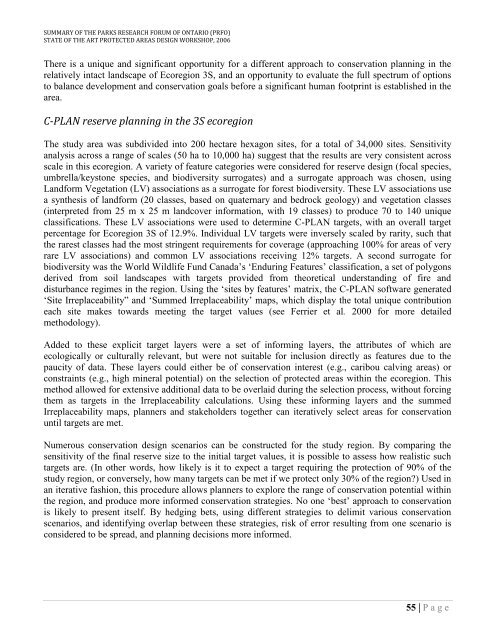Top-Down vs. Bottom Up: Working Towards Consensus ... - CASIOPA
Top-Down vs. Bottom Up: Working Towards Consensus ... - CASIOPA
Top-Down vs. Bottom Up: Working Towards Consensus ... - CASIOPA
- No tags were found...
Create successful ePaper yourself
Turn your PDF publications into a flip-book with our unique Google optimized e-Paper software.
SUMMARY OF THE PARKS RESEARCH FORUM OF ONTARIO (PRFO)STATE OF THE ART PROTECTED AREAS DESIGN WORKSHOP, 2006There is a unique and significant opportunity for a different approach to conservation planning in therelatively intact landscape of Ecoregion 3S, and an opportunity to evaluate the full spectrum of optionsto balance development and conservation goals before a significant human footprint is established in thearea.C-PLAN reserve planning in the 3S ecoregionThe study area was subdivided into 200 hectare hexagon sites, for a total of 34,000 sites. Sensitivityanalysis across a range of scales (50 ha to 10,000 ha) suggest that the results are very consistent acrossscale in this ecoregion. A variety of feature categories were considered for reserve design (focal species,umbrella/keystone species, and biodiversity surrogates) and a surrogate approach was chosen, usingLandform Vegetation (LV) associations as a surrogate for forest biodiversity. These LV associations usea synthesis of landform (20 classes, based on quaternary and bedrock geology) and vegetation classes(interpreted from 25 m x 25 m landcover information, with 19 classes) to produce 70 to 140 uniqueclassifications. These LV associations were used to determine C-PLAN targets, with an overall targetpercentage for Ecoregion 3S of 12.9%. Individual LV targets were inversely scaled by rarity, such thatthe rarest classes had the most stringent requirements for coverage (approaching 100% for areas of veryrare LV associations) and common LV associations receiving 12% targets. A second surrogate forbiodiversity was the World Wildlife Fund Canada‟s „Enduring Features‟ classification, a set of polygonsderived from soil landscapes with targets provided from theoretical understanding of fire anddisturbance regimes in the region. Using the „sites by features‟ matrix, the C-PLAN software generated„Site Irreplaceability” and „Summed Irreplaceability‟ maps, which display the total unique contributioneach site makes towards meeting the target values (see Ferrier et al. 2000 for more detailedmethodology).Added to these explicit target layers were a set of informing layers, the attributes of which areecologically or culturally relevant, but were not suitable for inclusion directly as features due to thepaucity of data. These layers could either be of conservation interest (e.g., caribou calving areas) orconstraints (e.g., high mineral potential) on the selection of protected areas within the ecoregion. Thismethod allowed for extensive additional data to be overlaid during the selection process, without forcingthem as targets in the Irreplaceability calculations. Using these informing layers and the summedIrreplaceability maps, planners and stakeholders together can iteratively select areas for conservationuntil targets are met.Numerous conservation design scenarios can be constructed for the study region. By comparing thesensitivity of the final reserve size to the initial target values, it is possible to assess how realistic suchtargets are. (In other words, how likely is it to expect a target requiring the protection of 90% of thestudy region, or conversely, how many targets can be met if we protect only 30% of the region?) Used inan iterative fashion, this procedure allows planners to explore the range of conservation potential withinthe region, and produce more informed conservation strategies. No one „best‟ approach to conservationis likely to present itself. By hedging bets, using different strategies to delimit various conservationscenarios, and identifying overlap between these strategies, risk of error resulting from one scenario isconsidered to be spread, and planning decisions more informed.55 | P a g e


